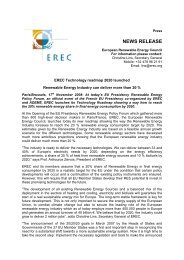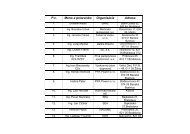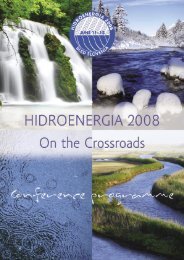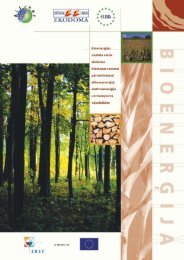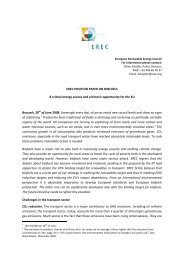Geothermal - European Renewable Energy Council
Geothermal - European Renewable Energy Council
Geothermal - European Renewable Energy Council
Create successful ePaper yourself
Turn your PDF publications into a flip-book with our unique Google optimized e-Paper software.
Binary cycle power plants<br />
Binary, known also as organic Rankine<br />
cycle (ORC), plants operate usually with<br />
waters in the 100 to 180°C temperature<br />
range. In these plants, the heat is recovered<br />
from the geothermal fluid, via a heat exchanger,<br />
to vaporize a low boiling point organic fluid<br />
and drive an organic vapour turbine. The heat<br />
depleted geothermal brine is pumped back into<br />
the source reservoir, thus securing sustainable<br />
resource exploitation. Since the geothermal<br />
and working fluids are kept separated during<br />
the process there are little if any atmospheric<br />
emissions. Adequate working fluid selection may<br />
allow to extend the former design temperature<br />
range from 180°C to 75°C.<br />
Upper and lower temperature limits depend on<br />
the organic fluid stability and techno-economic<br />
considerations respectively. At low temperatures<br />
the size required by the heat exchangers could<br />
defeat project economic-viability. Apart from low<br />
to medium temperature utilisation, geothermal<br />
and waste fluid binary process can be contemplated<br />
to avoid well scaling damage further to<br />
in-hole flashing, in which case submersible<br />
pumps are used to produce the geothermal<br />
fluid under pressure.<br />
Binary power<br />
plants.<br />
Binary processes are emerging as a cost effective<br />
conversion technology for recovering<br />
power from, water dominated, geothermal<br />
fields at temperatures below 180°C Recently,<br />
a new candidate binary process, known as the<br />
Kalina cycle, has been developed displaying<br />
attractive conversion efficiencies. It’s distinctive<br />
features address an ammonia-water working<br />
fluid mixture and regenerative heating. In brief,<br />
it takes advantage of the low boiling point of the<br />
water-ammonia mixture to allow a significant<br />
fraction of it to be vaporised by the excess<br />
heat available at turbine exhaust. The gains<br />
over conventional ORC plant efficiencies have<br />
been estimated at 40%, although its reliability<br />
and performances are yet to be demonstrated<br />
on long terms plant service.<br />
Reclamation of low temperature geothermal<br />
sources, achievable via binary cycles, can significantly<br />
increase the overall worldwide exploitation<br />
potential. Small scale geothermal binary plants<br />
(< 5 MW e<br />
ratings) can be widely implemented in<br />
rural areas and, more generally, respond to an<br />
increasingly disseminated human demand.<br />
6 EGEC | <strong>Geothermal</strong> Electricity and Combined Heat & Power


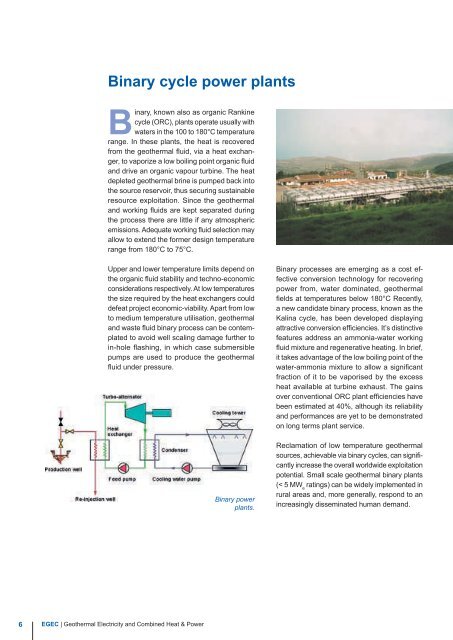

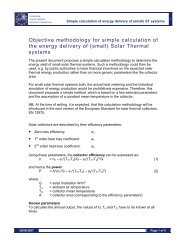
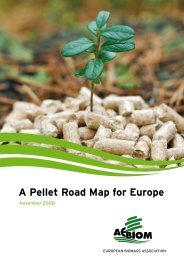
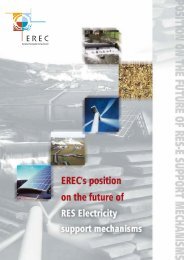

![Energy [R]evolution - Greenpeace](https://img.yumpu.com/47174859/1/184x260/energy-revolution-greenpeace.jpg?quality=85)
